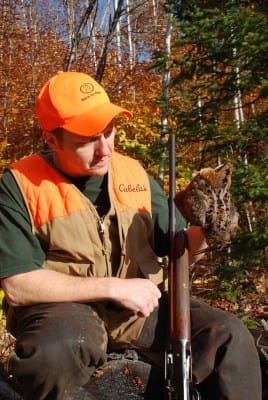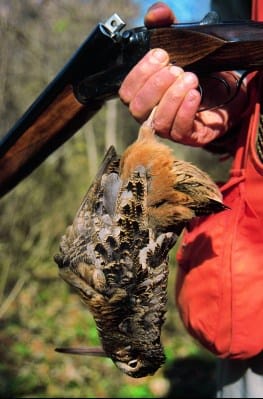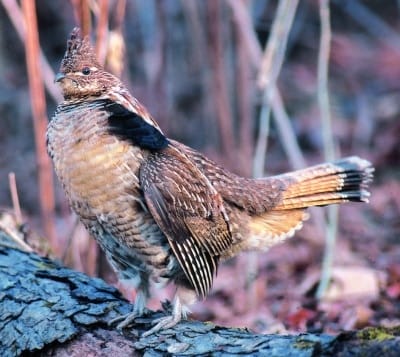
Among hunters nationwide, few would argue the rich heritage surrounding the pursuit of upland birds while in the company of a well-trained canine. To take this notion of dog and sportsman afield working together a step further, let’s consider two of the most traditional upland species-ruffed grouse, and woodcock. For many, these extraordinary forest fowl and a fine-honed pointer are, for all intents and purposes, synonymous.
That said, is the dog-less hunter left out in the proverbial cold when the topic turns around to these birds of the timber? The answer is a resounding no; however, the man who finds himself without a bird dog will want to approach this particular game a bit differently than one in the habit of finding dog hair on his truck seats. Here are some quick, no-dog tips designed to help the gunner, sans hound, put more birds in the bag.
Woodcock
The two most important virtues for the dog-less hunter are patience and persistence. Woodcock, also known as timberdoodles or simply, ‘doodles, especially those in heavily-hunted locales, often sit notoriously tight, refusing to flush even when confronted with a size-12 boot not eight inches away. To combat this, it’s vital that soloists do two things, move through cover v-e-r-y slowly, taking the time to zig and zag into and out of likely looking areas and, number two, stopping frequently. As can be the case with cagy rooster pheasants, ‘doodles have a tendency to get nervous when a perceived disturbance, i.e. a hunter or predator, abruptly stops. Nerves, then, can lead to a flush; not always, but often enough to make stopping and admiring the scenery a noteworthy tactic.

Dog-less for more seasons than I care to recall, I nonetheless enjoyed many exciting and productive woodcock hunts in my native northeastern Ohio during the 1970s and into the early 80s. I concentrated my hunt efforts on the edges, or the less tangled portions of traditional cover. These included logging roads or skidder paths, relatively new tree plantings or reforestation projects, and young-10 years or newer-timber harvests. Hunting as I did served two purposes; one, such comparatively light cover typically meant a shot opportunity at any flush, and heaven knows I needed all the shot opportunities I could get. Two, this same light cover meant that should my shot be on the mark, I stood a much better chance of locating the downed bird.
It’s at this point where persistence comes into play. Masters of camouflage, ‘doodles can be almost impossible to spot against a backdrop of autumn’s array of browns, blacks, and tans. The dog-less gunner will want to, if not already, get into the habit of never taking his eyes, or ears for that matter, off a falling bird. At the shot, it’s best if a hunter move immediately to the recovery area, stopping once close for the chance to hear the bird’s final flutters against the leaves. If the bird isn’t immediately found, a blaze orange hat can be used to mark the fall. Ever-increasing circles can then be paced, out and away from the site. Here, persistence will usually pay off.
Ruffed Grouse
Much of what has already been discussed pertaining to woodcock can be related directly to ruffed grouse in terms of the dog-less gunner finding and flushing birds, with, perhaps, a bit more emphasis on the patience aspect. Grouse, especially pressured ruffs, often get spooky. Long-distance flushes and the accompanying frustrations become the norm. To combat this, hunters should use stealth when approaching coverts, including measures such as maintaining noise discipline and working cover from the downwind side if possible.
The bulk of my ruffed grouse hunting experience, and all of my blue grouse knowledge, comes courtesy of the Cascade Range in western Washington. Here, my wife and I, dog-less for the first couple years of my Pacific Northwest residency, would drive the gravel logging roads of the Gifford Pinchot National Forest during the early morning hours, the time when ruffs and blues both could commonly be found roadside picking grit and nipping the occasional dandelion blossom. Sightings or cover that simply screamed grouse warranted a stop, and a 30 to 45-minute meander through the alders, huckleberries, and young firs. More times than not, our efforts were met with the roar of grouse wings. As for the shooting, well, that wasn’t always as productive.

Hunting grouse and woodcock, the kings of upland game birds, in the company of a wonderful pointer or Labrador is, without question, one of the finest examples of our grand sport. However, not having a dog certainly doesn’t translate into no hunting when the alders turn gold, and the mountain air carries with her a chill well throughout the morning.



